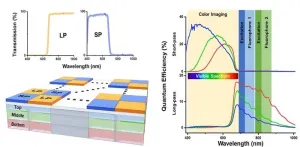(Press-News.org) Earth’s magnetic field, generated by the flow of molten iron in the planet’s inner core, extends out into space and protects us from cosmic radiation emitted by the Sun. It is also, remarkably, used by animals like salmon, sea turtles and migratory birds for navigation.
But how? And why? A new study from researchers at Western’s Advanced Facility for Avian Research (AFAR), home to the world’s first hypobaric climatic wind tunnel for bird flight, explores a brain region called cluster N that migratory birds use to perceive Earth’s magnetic field. The team discovered the region is activated very flexibly, meaning these birds have an ability to process, or ignore, geomagnetic information, just as you may attend to music when you are interested or tune it out when you are not.
More specifically, the research team led by psychology PhD candidate Madeleine Brodbeck and AFAR co-director Scott MacDougall-Shackleton studied white-throated sparrows and found they were able to activate cluster N at night when they were motivated to migrate (to avoid prey and fly during cooler periods) and make it go dormant when they were resting at a stopover site.
This is the first demonstration of this brain region functioning in a North American bird species, as all prior research in this area was completed in Europe.
“This brain region is super important for activating the geomagnetic compass, especially for songbirds when they migrate at night,” said Brodbeck. “Almost all previous work on this specific brain function was done at one lab in Europe, so it was great to replicate it in a North American bird like the white-throated sparrow.”
Earth’s magnetic field, likely first investigated and identified by German mathematician Carl Friedrich Gauss in the 1830s, has long fascinated physicists, aerospace engineers and even science fiction writers like Frank Herbert and Stephen King. Brodbeck, a bird psychologist, is equally intrigued.
“Magnetic fields are really fun to think about because they’re invisible to humans. We can’t see them or sense them, but most animals perceive them in some way,” said Brodbeck. “For birds, using Earth’s magnetic field to know if they’re going towards a pole or towards the equator is obviously really helpful for orientation and migration. It’s incredible that they can activate their brain in this way, and we can’t.”
Understanding the physical mechanisms of how animals make their way around in the world is a fundamentally important question for researchers, says MacDougall-Shackleton, a psychology professor and cognitive neuroscientist.
“If we want to understand bird migration or how other animals move from one place to another, we need to know how they do it. And more importantly, we need to know what we’re doing, as humans, that might influence them,” said MacDougall-Shackleton.
The findings were published in the journal, European Journal of Neuroscience.
“Birds don’t just use their magnetic compass. We know they pay attention to the Sun and the stars as cues too. And we also know that things like lights at night, or windows in buildings, and all these things that we put in the world disrupt their migrations,” said MacDougall-Shackleton. “This type of basic research informs us and lets us know the full suite of ways that animals perceive the world when they’re migrating and what we as humans need to do to minimize our impact.”
END
Bird brains can flick switch to perceive Earth’s magnetic field
Research on how animals move around the world helps determine the influence of human activity
2023-05-26
ELSE PRESS RELEASES FROM THIS DATE:
Food for thought: UH study highlights the role of clean technology in reducing food waste
2023-05-26
Foodservice companies have long struggled with the challenge of what to do with all of their food waste. But researchers at the University of Houston Conrad N. Hilton College of Global Hospitality Leadership are shedding light on how clean technology can help those companies reduce waste and establish long-term sustainability goals.
In a study published in the Journal of Hospitality & Tourism Research, Tiffany S. Legendre, an associate professor at Hilton College, and her team, interviewed 17 leaders of the country’s largest on-site foodservice providers (e.g., Aramark, Compass and Sodexo), ...
Illinois Tech announced as enrollment partner in NIH’s AI precision nutrition research, largest project of its kind
2023-05-26
CHICAGO—May 26, 2023—Illinois Institute of Technology is one of 14 institutions chosen as an enrollment site for the National Institute of Health’s landmark initiative to advance nutrition research. Nutrition for Precision Health (NPH), powered by the All of Us Research Program, is working to engage 10,000 participants from diverse backgrounds across the United States with the aim of learning about how our bodies respond differently to food.
NPH will use artificial intelligence–based ...
World leader in photonics gives talk at Aston University
2023-05-26
Talk by one of the leading lights in optical communications
Dr. Ming-Jun Li is currently a corporate fellow at Corning Incorporated
He discussed installed optical fibres for ultra-wideband transmission systems.
26 May 2023 | Birmingham, UK
Aston University has hosted one of the leading lights in optical communications and speciality optical fibres at its second international photonics workshop.
Dr. Ming-Jun Li is currently a corporate fellow at Corning Incorporated in the USA and headed ...
GPS tracking reveals how a female baboon stopped using urban space after giving birth
2023-05-26
A new study from Swansea University and the University of Cape Town provides the first documented evidence of a cessation in urban space use by a female baboon after giving birth: another example of how wild animals are adaptively responding to urbanisation.
The study, recently published in the journal Ecology & Evolution, used GPS collars to track the movements of 13 chacma baboons in Cape Town, South Africa.
The data revealed that when one collared female gave birth, she stopped using urban space without any significant change in daily distance travelled or social interactions that would be expected with general risk-sensitive behaviour during this ...
Tree islands bring biodiversity to oil palm plantations
2023-05-26
Islands of trees in oil palm plantations can significantly increase biodiversity within five years without reducing productivity. This has been shown by an experiment, which has been running for over ten years in Indonesia as part of the Collaborative Research Centre (CRC) "EFForTS" at the University of Göttingen. An international team of researchers led by Göttingen planted experimental islands of trees in plantations on the island of Sumatra to counteract the species loss caused by the ...
Innovative endoscopic imaging system can detect multiple fluorescent tracers
2023-05-26
For patients with solid cancers, endoscopic surgery is one of the primary treatment options to remove tumors. However, there is a high risk of cancer recurrence if even a small number of cancerous cells are left behind after surgical resection. To prevent this from happening, researchers developed fluorescence-guided surgery (FGS). In FGS, patients are injected with a fluorescent probe that preferentially binds to tumor cells, enabling surgeons to easily identify lesions with the help of specialized endoscopes that emit the necessary excitation light.
Unfortunately, tumors can be highly heterogeneous, ...
CHOP researchers show that IgA fine tunes the body’s interactions with microbes
2023-05-26
Philadelphia, May 26, 2023—IgA deficiency is the most common primary immune deficiency worldwide, but its presentation has puzzled physcians and researchers. Some with the disorder present with symptoms like recurrent infections, autoimmune disease, or allergies, whereas others have no symptoms at all and only become aware of their IgA-deficient status through an incidental finding on a blood test. This variability has raised the question among researchers: Why aren’t many of those with IgA deficiency sicker?
A new study by researchers at Children’s ...
Protein-based nano-‘computer’ evolves in ability to influence cell behavior
2023-05-26
HERSHEY, Pa. — The first protein-based nano-computing agent that functions as a circuit has been created by Penn State researchers. The milestone puts them one step closer to developing next-generation cell-based therapies to treat diseases like diabetes and cancer.
Traditional synthetic biology approaches for cell-based therapies, such as ones that destroy cancer cells or encourage tissue regeneration after injury, rely on the expression or suppression of proteins that produce a desired action within a cell. This approach can take time (for proteins ...
Gene therapy rescues hearing for the first time in aged mouse models
2023-05-26
By 2050, one in 10 individuals are expected to live with some form of hearing loss. Of the hundreds of millions of cases of hearing loss affecting individuals worldwide, genetic hearing loss is often the most difficult to treat. While hearing aids and cochlear implants offer limited relief, no available treatment can reverse or prevent this group of genetic conditions, prompting scientists to evaluate gene therapies for alternative solutions.
One of the most promising tools used in these therapies—adeno associated virus (AAV) vectors—has galvanized the hearing-loss community in recent years. ...
The mechanisms behind swallowing
2023-05-26
Sensory cells in the vagus nerve can detect and locate food in the esophagus. Their signals help transport the food onward to the stomach. Signal failure leads to swallowing disorders, say a team led by Carmen Birchmeier at the Max Delbrück Center. They have published their findings in “Neuron.”
Swallowing disorders can have many causes, and they occur more frequently in older people. But neurological diseases such as multiple sclerosis and Parkinson’s disease, and certain medications, can also prevent food moving normally from mouth to stomach. Possible consequences include malnutrition, weight loss, and dehydration.
Now a team led ...
LAST 30 PRESS RELEASES:
Numbers in our sights affect how we perceive space
SIMJ announces global collaborative book project in commemoration of its 75th anniversary
Air pollution exposure and birth weight
Obstructive sleep apnea risk and mental health conditions among older adults
How talking slows eye movements behind the wheel
The Ceramic Society of Japan’s Oxoate Ceramics Research Association launches new international book project
Heart-brain connection: international study reveals the role of the vagus nerve in keeping the heart young
Researchers identify Rb1 as a predictive biomarker for a new therapeutic strategy in some breast cancers
Survey reveals ethical gaps slowing AI adoption in pediatric surgery
Stimulant ADHD medications work differently than thought
AI overestimates how smart people are, according to HSE economists
HSE researchers create genome-wide map of quadruplexes
Scientists boost cell "powerhouses" to burn more calories
Automatic label checking: The missing step in making reliable medical AI
Low daily alcohol intake linked to 50% heightened mouth cancer risk in India
American Meteorological Society announces Rick Spinrad as 2026 President-Elect
Biomass-based carbon capture spotlighted in newly released global climate webinar recording
Illuminating invisible nano pollutants: advanced bioimaging tracks the full journey of emerging nanoscale contaminants in living systems
How does age affect recovery from spinal cord injury?
Novel AI tool offers prognosis for patients with head and neck cancer
Fathers’ microplastic exposure tied to their children’s metabolic problems
Research validates laboratory model for studying high-grade serous ovarian cancer
SIR 2026 delivers transformative breakthroughs in minimally invasive medicine to improve patient care
Stem Cell Reports most downloaded papers of 2025 highlight the breadth and impact of stem cell research
Oxford-led study estimates NHS spends around 3% of its primary and secondary care budget on the health impacts of heat and cold in England
A researcher’s long quest leads to a smart composite breakthrough
Urban wild bees act as “microbial sensors” of city health.
New study finds where you live affects recovery after a hip fracture
Forecasting the impact of fully automated vehicle adoption on US road traffic injuries
Alcohol-related hospitalizations from 2016 to 2022
[Press-News.org] Bird brains can flick switch to perceive Earth’s magnetic fieldResearch on how animals move around the world helps determine the influence of human activity






